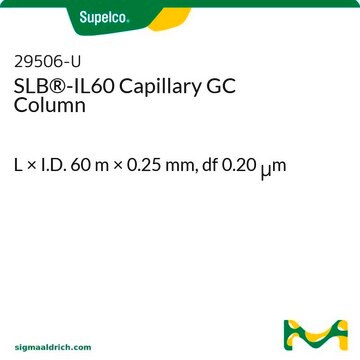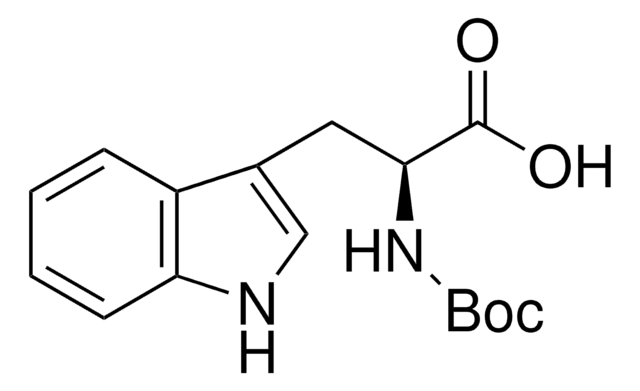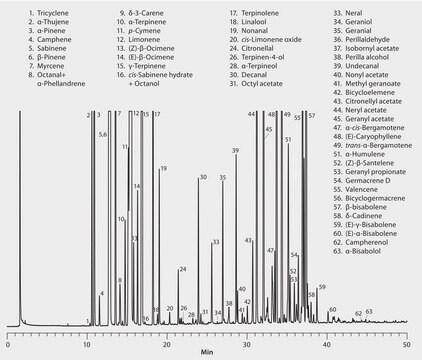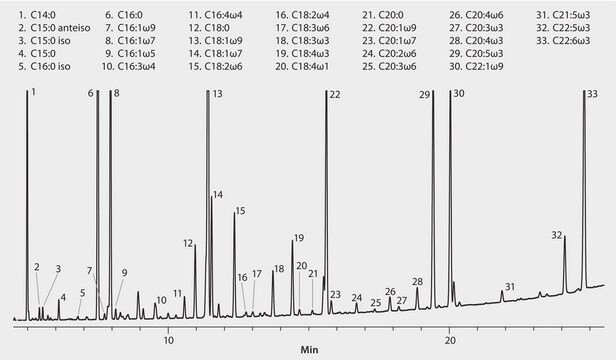Wszystkie zdjęcia(1)
Kluczowe dokumenty
24111
SP®-2380 Capillary GC Column
L × I.D. 60 m × 0.25 mm, df 0.20 μm
Zaloguj sięWyświetlanie cen organizacyjnych i kontraktowych
About This Item
Kod UNSPSC:
41115710
eCl@ss:
32119290
Polecane produkty
Materiały
fused silica
Poziom jakości
agency
meets requirements for USP G48
Parametry
≤25-275 °C temperature (isothermal or programmed)
Wartość beta
313
df
0.20 μm
metody
gas chromatography (GC): suitable
dł. × śr. wewn.
60 m × 0.25 mm
grupa aktywna macierzy
Stabilized; poly(90% biscyanopropyl/10% cyanopropylphenyl siloxane) phase
Zastosowanie
agriculture
chemicals and industrial polymers
clinical
food and beverages
typ kolumny
capillary highly polar
Szukasz podobnych produktów? Odwiedź Przewodnik dotyczący porównywania produktów
Opis ogólny
Application: A highly polar cyanosiloxane column commonly used for separation of geometric (cis/trans) fatty acid methyl ester (FAME) isomers as a group. Also useful when a highly polar general purpose column with good thermal stability is required.
USP Code: This column meets USP G48 requirements.
Phase:
USP Code: This column meets USP G48 requirements.
Phase:
- Stabilized
- Poly(90% biscyanopropyl/10% cyanopropylphenyl siloxane)
- Subambient to 275 °C (isothermal or programmed)
Zastosowanie
- SP®-2380 Capillary Column may be suitable for determination of fatty acid composition in crude oil using capillary gas chromatography, used along with normal and reverse-phase high-performance liquid chromatography (HPLC) in order to study the content and composition of tocopherols, sterols, and phospholipids in soybean oils derived from genetically-modified soybeans.
- It was also found suitable to be used for the identification of fatty acid methyl esters from mammalian samples by fast gas chromatography.
- Furthermore, it is also suitable for determining the hydrogenation level and the level of isomerisation development during the hydrogenation process of edible oils by capillary gas chromatography.
- Above all that it is also suitable to be used in gas chromatography equipped with flame ionization detector (FID) for analysing the cytotoxicity of fatty acids from seed oils containing conjugated linolenic acids (CLN) on mouse tumor and human monocytic leukemia cells.
Inne uwagi
We offer a variety of chromatography accessories including analytical syringes
Informacje prawne
SP is a registered trademark of Sigma-Aldrich Co. LLC
Ta strona może zawierać tekst przetłumaczony maszynowo.
Wybierz jedną z najnowszych wersji:
Masz już ten produkt?
Dokumenty związane z niedawno zakupionymi produktami zostały zamieszczone w Bibliotece dokumentów.
Klienci oglądali również te produkty
Effect of genetic modification on the content and composition of bioactive constituents in soybean oil.
Mounts TL
Journal of the American Oil Chemists' Society, 73 (5), 581-586 (1996)
E M Bondia et al.
Journal of chromatography. B, Biomedical applications, 658(2), 369-374 (1994-08-19)
Total fatty acids in plasma of neonates have been analysed as their methyl esters by gas chromatography. They were separated on a capillary column coated with a SP-2380 stationary phase. As little as 100 microliters of plasma is used for
Fast gas chromatography for the identification of fatty acid methyl esters from mammalian samples.
Stark K and Salem N.
Liposome Technology, 17 (8), 181-181 (2005)
Use of capillary gas chromatography for determining the hydrogenation level of edible oils.
Mateja N and Smidovnik A.
Journal of Chromatography A, 767 (1), 335-339 (1997)
P K Kindel et al.
Carbohydrate research, 199(1), 55-65 (1990-05-15)
The complete acetylation of apiitol required 9 h when acetic anhydride at 120 degrees was used and sodium acetate was the catalyst. Both apiitol pentaacetate and apiitol tetraacetate were detected before acetylation was complete. When the reaction was done in
Nasz zespół naukowców ma doświadczenie we wszystkich obszarach badań, w tym w naukach przyrodniczych, materiałoznawstwie, syntezie chemicznej, chromatografii, analityce i wielu innych dziedzinach.
Skontaktuj się z zespołem ds. pomocy technicznej






